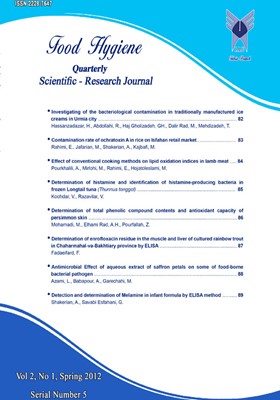Effect of attenuated lactobacillus plantarum as adjunct starter on lipolysis and organoleptic characteristics of UF white cheese
Subject Areas : Food Science and Technology
رامین Atazadeh
1
![]() ,
گیتی Karim
2
,
گیتی Karim
2
![]() ,
جواد Hesari
3
,
شهرام Hanifian
4
,
جواد Hesari
3
,
شهرام Hanifian
4
1 - Ph.D Student of Food Hygiene, Faculty of Specialized Veterinary Science, Science and Research Branch, Islamic Azad University, Tehran, Iran.
2 - Professor of Food Hygiene Department, Faculty of Veterinary Medicine, University of Tehran, Tehran, Iran
3 - Associate Professor of Food Science and Technology Department, Faculty of Agriculture, Tabriz University, Tabriz, Iran.
4 - Assistant Professor of Food Science and Technology Department, Faculty of Agriculture, Tabriz Branch, Islamic Azad University, Tabriz, Iran
Keywords: Attenuated adjunct starter, Lactobacilli plantarum, lipolysis, UF white cheese,
Abstract :
The main objective of this study was to determine the effect of attenuated adjunct culture of lactobacillus plantarum on the lipolysis of UF-white cheese as measured by acid degree value, the fatty acids profile, physicochemical, microbial and sensory characteristics during ripening. The results showed that, treated UF cheeses exhibited no significant (p>0.05) differences in chemical composition (dry matter, fat, salt and pH) in comparison with the control UF cheeses throughout 60 days of ripening. Total bacterial count and mesophilic lactobacillus count in the UF cheeses using attenuated adjunct starter were significantly (p<0.01) higher than the control cheeses after 45 days of ripening. The results of fatty acid profiles revealed that due to increasing of the lipolysis in the first 30 days of ripening, the samples containing attenuated adjunct lactobacillus plantarum had significantly (p< 0.01) lower percentages of fatty acids with medium and short chains (C4:0-C14:0) in comparison with the control cheeses while the percentage of fatty acids with long chains (C16:0-C18:3) increased. Acid degree value, as indicated by total free fatty acids was significantly (p<0.01) higher in cheeses using attenuated adjunct lactobacillus plantarum. In organoleptic evaluation, UF cheeses received significantly (p<0.01) higher total scores than the control samples on day 45. Finally, it could be concluded that cheeses produced by attenuated adjunct lactobacillus plantarum have more nutritional quality than the control UF cheeses.


